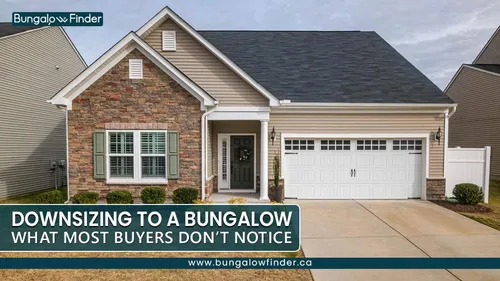How a 20% Down Payment Can Save You Money on Your Home
Learn how a 20% down payment can lower mortgage costs, eliminate insurance fees, and boost financial control. Bungalow Finder guides your smart purchase.

A 20% down payment isn't just a number—it’s a strategic financial move. This guide explains how putting down 20% can help Canadian homebuyers reduce their overall mortgage cost, avoid costly insurance, and gain more financial control.
Why the Down Payment Matters
When searching for a home for sale in Canada, one of the first financial decisions you’ll make is determining your down payment. While options like home financing with no down payment may seem appealing, especially for first-time buyers, they often result in higher long-term costs.
In contrast, a 20% down payment can significantly reduce your monthly payments, eliminate mortgage insurance premiums, and increase your equity from day one. This article explains why the 20% benchmark matters and how it can help you save money over time.
What Is a Down Payment?
A down payment is the initial upfront payment made when purchasing a property. In Canada, the amount of your down payment affects not only your mortgage but also whether you're required to pay mortgage default insurance.
Canada’s Minimum Down Payment Rules
Home Price | Minimum Down Payment |
$500,000 or less | 5% of the purchase price |
$500,000 to $999,999 | 5% of first $500,000 + 10% of the remainder |
$1 million or more | 20% of the purchase price |
For homes priced over $1 million, the minimum required is already 20%, making this an important threshold to understand early on.
Average Down Payment on a House in Canada
Down payment trends vary by location. While the national minimums are defined, most homes buyers aim for 15–20% to secure better mortgage rates and avoid insurance.
Average Down Payments by City (2025 Data)
City | Average Home Price | Typical Down Payment (%) | Approx. Amount |
Toronto | $1,050,000 | 20% | $210,000 |
Vancouver | $1,150,000 | 20% | $230,000 |
Calgary | $550,000 | 15% | $82,500 |
Halifax | $475,000 | 10% | $47,500 |
These figures reflect each region's market conditions, affordability, and regulatory requirements.
Benefits of a 20% Down Payment
1. You Avoid Mortgage Default Insurance
If your down payment is below 20%, you must legally pay for mortgage default insurance through the Canada Mortgage and Housing Corporation (CMHC) or another insurer. This insurance protects the lender—not the borrower—and can cost between 2.8% and 4% of the total mortgage amount.
For example, on a $700,000 home with only 5% down, CMHC insurance could cost you over $20,000. With 20% down, this fee is entirely avoided.
2. Lower Monthly Mortgage Payments
A larger down payment means you borrow less. That results in:
Smaller principal amounts
Less interest paid over the life of the loan
Lower monthly payments
For instance, buying a $700,000 home with 20% down reduces your mortgage amount to $560,000, compared to $665,000 with only 5% down. The monthly payment savings can be substantial—hundreds of dollars each month.
3. Lower Interest Rates and Better Terms
Lenders view a 20% down payment as a sign of financial stability. This can make you eligible for:
Lower mortgage interest rates
Fewer restrictions or conditions on your mortgage
Greater negotiating power with lenders
If you're exploring new homes or looking to stay competitive in the current housing market, a 20% down payment can give you the necessary advantage.
Calculating Your Down Payment
Use a reliable down payment calculator to determine how much you need to save. These tools typically require:
Purchase price
Desired down payment percentage
Mortgage term
Estimated interest rate
The Government of Canada Down Payment Calculator can help you estimate your numbers based on real-time data.
Cost Comparison: 5% vs. 20% Down
Let’s consider a $600,000 home purchase.
Down Payment | Mortgage Amount | CMHC Insurance | Monthly Payment (5% interest) | Total Cost Over 25 Years |
5% ($30,000) | $570,000 | $22,800 | ~$3,456 | ~$1,036,800 |
20% ($120,000) | $480,000 | $0 | ~$2,800 | ~$840,000 |
Savings: $196,800 over the life of the loan by putting down 20%.
What If You Can’t Afford 20%?
Buying a house with no down payment is extremely rare in Canada unless you're using specialized lender programs or private financing, which often come with strict conditions and higher costs.
If you don’t have 20%, consider:
First-Time Home Buyer Incentive (Shared equity loan with the federal government)
Home Buyers’ Plan (Withdraw up to $60,000 from your RRSPs tax-free)
Tax-Free First Home Savings Account (FHSA) contributions
These programs are designed to support homebuyers who want to grow their down payment and still access homeownership.
Is 20% Always the Right Choice?
While 20% provides financial benefits, it's not always feasible—especially in cities with high real estate prices. Some buyers prefer to enter the market sooner with 5–10% down and refinance later when their equity grows.
When 20% Makes Sense
You’re buying a property over $1 million (required)
You have strong savings and want to minimize interest and insurance costs
You plan to hold the property long-term
When Less Might Work
You're a first-time buyer with access to assistance programs
You expect strong future income growth
You prefer to keep liquid cash for other investments
Final Thoughts
A 20% down payment isn’t just about meeting a number—it’s about maximizing your savings, reducing your mortgage obligations, and setting yourself up for long-term financial success.
For Canadian buyers, especially in competitive real estate markets, reaching that 20% threshold can mean thousands of dollars saved in mortgage insurance and interest. If you plan to buy a home for sale this year, consider your options carefully and use tools like a down payment calculator to make the most informed decision.













